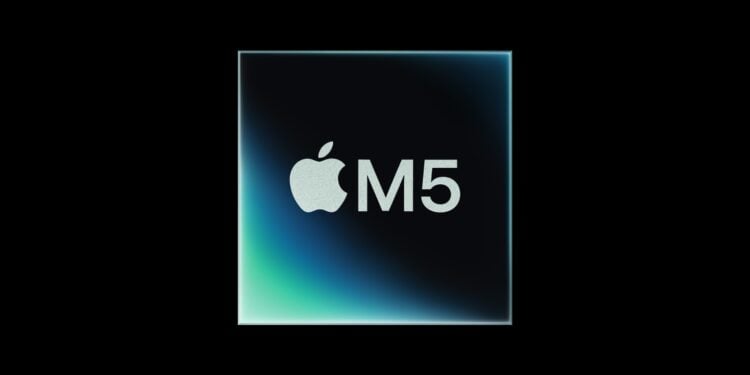Apple has introduced the new M5 chip—the most powerful member of the Apple Silicon lineup yet. The chip delivers significant advances in AI, graphics performance, and power efficiency. With a new GPU architecture, improved Neural Engine, and increased memory bandwidth, the M5 achieves a new level of engineering precision. Apple continues its strategy of optimally harmonizing hardware and software to combine maximum performance with minimal power consumption.
Since switching to its own processors, Apple has pursued a clear goal: to develop ever faster, more efficient, and more intelligent chips that work seamlessly with macOS, iPadOS, and visionOS. The M5 is the culmination of years of development work and symbolizes Apple's ambition to be at the forefront of the AI era. The focus is not just on speed, but on a sophisticated architecture that enables machine learning and sophisticated graphics processing directly on the device.
More performance thanks to new GPU architecture
The Apple M5 is based on the third generation of 3-nanometer technology and features a next-generation GPU with ten cores. Each of these cores contains its own neural accelerator, enabling AI workloads to run significantly faster. Compared to the M4, the M5 achieves more than four times the GPU processing power, delivering the highest AI performance of an Apple chip to date. Compared to the M1, the GPU performance is even more than six times higher.
The new GPU architecture not only delivers faster AI processing but also significantly increases graphics performance. According to Apple, the gain is up to 45 percent compared to the M4. The M5 utilizes third-generation ray tracing and second-generation dynamic caching, resulting in smoother rendering, more realistic lighting effects, and reduced rendering times.
There are also noticeable improvements for devices like the Apple Vision Pro. The M5 renders around ten percent more pixels and enables refresh rates of up to 120 Hz. The result is sharper details, smoother display, and reduced motion blur.
Faster CPU and optimized Neural Engine
Inside is a CPU with up to ten cores, consisting of four performance cores and six efficiency cores. This gives the M5 up to 15 percent higher multithreaded performance than the M4. Apple also calls it the world's fastest performance core.
The Neural Engine plays a central role in AI functions. It comprises 16 cores and is designed for maximum energy efficiency. Combined with the Neural Accelerators in the CPU and GPU, the entire chip is optimized for AI tasks. This is evident, for example, in features of the Apple Vision Pro: 2D photos can be converted into 3D scenes more quickly, and the generation of a digital persona is also more fluid.
The faster Neural Engine also improves the performance of Apple Intelligence, the new AI system for devices like the MacBook, iPad, and iPhone. Tools like Image Playground work more efficiently, and developers using Apple's Foundation Models framework also benefit from the increased speed.
More bandwidth for larger AI models
The M5 offers a unified memory bandwidth of 153 GB/s—around 30 percent more than the M4 and more than double that of the M1. This architecture allows the entire chip to access a shared memory pool, allowing large AI models to run entirely on-device without relying on cloud computing.
With up to 32 GB of storage capacity, multiple demanding applications can be used simultaneously. Creative programs like Adobe Photoshop and Final Cut Pro run in parallel while large files are uploaded to the cloud in the background. This provides greater flexibility while maintaining stability.
Developer-friendly integration into the Apple ecosystem
The M5's architecture is tightly integrated with Apple's software frameworks. Applications that use Core ML, Metal Performance Shaders, or Metal 4 automatically benefit from the increased computing power. Developers can directly access the neural accelerators via Tensor APIs, allowing them to develop their own solutions for AI-based apps. This deep integration ensures that existing software benefits from the new hardware without any adaptations.
Energy efficiency and environmental goals
In addition to performance, energy efficiency remains a key focus. The M5 is designed to reduce energy consumption throughout its lifetime, supporting Apple's goal of becoming completely carbon neutral by 2030. Improvements in the chip architecture contribute to reducing CO₂ emissions in the areas of materials, power consumption, and transportation.
Devices with the new M5 chip
The M5 will initially be used in three products: the new 14-inch MacBook Pro, the iPad Pro, and the Apple Vision Pro. All models benefit from the chip's AI and graphics advancements. The devices are available for pre-order now.
- New iPad Pro with M5 chip: The tablet of the future
- MacBook Pro 14" with M5: The new benchmark for performance
- Apple Vision Pro with M5 chip: Faster, clearer, better
M5: Apple Silicon reaches the next stage of development
With the M5, Apple demonstrates that developing its own chips remains a decisive advantage. The new processor combines greater processing power, improved AI capabilities, and more efficient energy use. It elevates the Mac, iPad, and Vision Pro to a new technical level and underscores Apple's commitment to leadership in both performance and sustainability. The M5 represents the next step in the evolution of Apple Silicon—more powerful, smarter, and more efficient than ever before. (Image: Apple)
- Apple faces expensive tax dilemma in India
- Apple shows teaser: MacBook Pro M5 is about to launch
- iPhone 17: Why the selfie camera has changed a lot
- Market report: iPhone 17 catapults Apple to the top
- Apple TV has significantly more subscribers than expected
- Apple launches new clean energy projects in Europe and China
- All highlights of iOS 26.1 Beta 3 at a glance
- macOS 26.1 Beta 3 hints at a revised XDR display
- Apple presents eight AI studies at ICCV 2025
- iOS 26.1 Beta 3 brings hints of upcoming AI partners
- Apple TV gets a new app icon with iOS 26.1 & tvOS 26.1
- Apple TV+ is renamed – Apple TV is the new name
- F1 The Movie: From December 12, 2025 exclusively on Apple TV
- Apple confirms iPhone Air launch in China after delay
- Apple discontinues Clips app: End of a creative era





